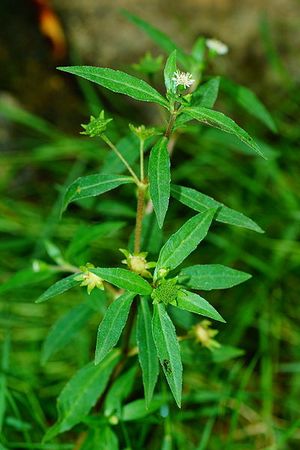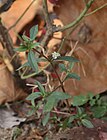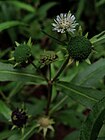Note: This is a project under development. The articles on this wiki are just being initiated and broadly incomplete. You can Help creating new pages.
Eclipta prostrata - Bhrngaraja
Eclipta prostrata is a species of plant in the sunflower family. It is widespread across much of the world. It is widely distributed throughout India, Nepal. This plant is belongs to Asteraceae family.[1]
Uses
Loss of appetite, Asthma, Productive cough, Hyperlipidemia, Mild hypertension, Intestinal worm, Jaundice, Piles, Abdominal pain, Hairfall, Preature greying of hair, Lucoderma.
Parts Used
Chemical Composition
Wedelolactone, Luteolin, Apigenin, Triterpenoids – Eclalbatin, alpha-amyrin, oleanolic acid, ursolic acid, Flavonoids – apigenin and luteolin, Wedelolactone,Echinocystic acid glycosides, β-Sitosterol, Daucosterol.[2]
Common names
| Language | Common name |
|---|---|
| Kannada | Ajagara |
| Hindi | Bhrngaraj, Kesharaj |
| Malayalam | Kannunni |
| Tamil | Karisilanganni, Kavanthakara |
| Telugu | Galagara |
| Marathi | NA |
| Gujarathi | NA |
| Punjabi | NA |
| Kashmiri | NA |
| Sanskrit | Bhrngaraja |
| English | False Daisy, Trailing eclipta |
Properties
Reference: Dravya - Substance, Rasa - Taste, Guna - Qualities, Veerya - Potency, Vipaka - Post-digesion effect, Karma - Pharmacological activity, Prabhava - Therepeutics.
Dravya
Rasa
Tikta (Bitter), Katu (Pungent)
Guna
Laghu (Light), Ruksha (Dry)
Veerya
Ushna (Hot)
Vipaka
Katu (Pungent)
Karma
Prabhava
Habit
Identification
Leaf
| Kind | Shape | Feature |
|---|---|---|
| Simple | Lanceolate | Leaf Apex is Acute, Leaf Base is Cuneate and Leaf Margin is Serrate-dentate. |
.[3]
Flower
| Type | Size | Color and composition | Stamen | More information |
|---|---|---|---|---|
| Bisexual | 2.5 cm long | White | 5-20 | In axillary or terminal 1-3 capitula; white. Flowering from December-May |
Fruit
| Type | Size | Mass | Appearance | Seeds | More information |
|---|---|---|---|---|---|
| Oblong achene | An oblong achene, 3-quetrous, hairy above. Fruiting January onwards | {{{6}}} |
Other features
List of Ayurvedic medicine in which the herb is used
Where to get the saplings
Mode of Propagation
How to plant/cultivate
Can be raised both from seed as well as stem cuttings. Seed is preferred for raising plantation. Seed germination is 75-85% when freshly collected mature seeds are sown in a well prepared nursery.[5]
Commonly seen growing in areas
Photo Gallery
References
- ↑ Karnataka Aushadhiya Sasyagalu By Dr.Maagadi R Gurudeva, Page no:117
- ↑ "chemical composition"
- ↑ "morphology"
- ↑ "Ayurvedic preparations"
- ↑ "Cultivation Details"
External Links
- Ayurvedic Herbs known to be helpful to treat Loss of appetite
- Ayurvedic Herbs known to be helpful to treat Asthma
- Ayurvedic Herbs known to be helpful to treat Productive cough
- Ayurvedic Herbs known to be helpful to treat Hyperlipidemia
- Ayurvedic Herbs known to be helpful to treat Mild hypertension
- Ayurvedic Herbs known to be helpful to treat Intestinal worm
- Ayurvedic Herbs known to be helpful to treat Jaundice
- Ayurvedic Herbs known to be helpful to treat Piles
- Ayurvedic Herbs known to be helpful to treat Abdominal pain
- Ayurvedic Herbs known to be helpful to treat Hairfall
- Ayurvedic Herbs known to be helpful to treat Preature greying of hair
- Ayurvedic Herbs known to be helpful to treat Lucoderma
- Herbs with Young shoots used in medicine
- Herbs with Leaves used in medicine
- Herbs with common name in Kannada
- Herbs with common name in Hindi
- Herbs with common name in Malayalam
- Herbs with common name in Tamil
- Herbs with common name in Telugu
- Herbs with common name in Sanskrit
- Herbs with common name in English
- Habit - Annual plant
- Index of Plants which can be propagated by Seeds
- Index of Plants which can be propagated by Cuttings
- Herbs that are commonly seen in the region of Poorly drained area
- Herbs that are commonly seen in the region of Wet areas
- Herbs
- Asteraceae





